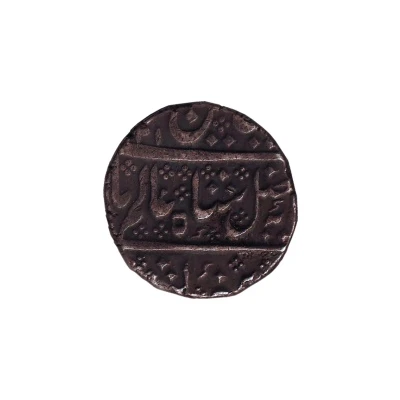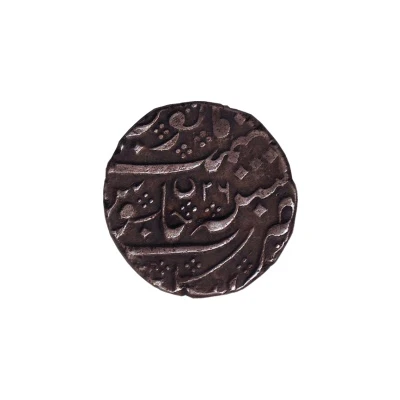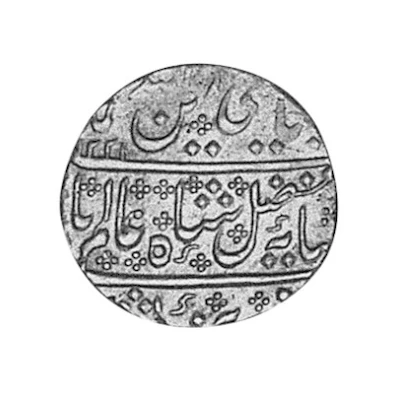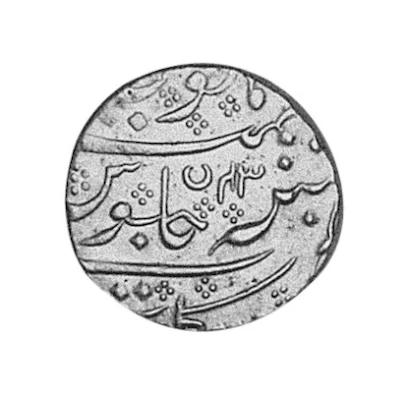


1 Rupee - Shah Alam II Arcot
| Silver | 11.4 g | 24.7 mm |
| Issuer | Arcot (French India) |
|---|---|
| Type | Standard circulation coin |
| Years | 1177-1222 (1764-1807) |
| Calendar | Islamic (Hijri) |
| Value | 1 Rupee (1 Roupie) |
| Currency | Rupee |
| Composition | Silver |
| Weight | 11.4 g |
| Diameter | 24.7 mm |
| Shape | Round (irregular) |
| Demonetized | Yes |
| Updated | 2024-10-05 |
| Numista | N#22014 |
|---|---|
| Rarity index | 53% |
Reverse
Zarb Arkat / sanat 44 julus / maimanet / manus.
(Legend from bottom to top and from right to left)
Lettering: ٢٦
Translation: Struck at Arkat in the year 44 of his reign of tranquil prosperity.
Comment
The French were pretty desperate to have their own coins in the mughal style, seeing the benefits enjoyed by their English rivals. After a series of failed negotiations with the mughal authorities (which started as early as 1718), they finally managed to obtain the necessary permission from the Nawab of Arcot (which cost them a huge sum of money). The silver Rupees that bore the mint name Arkat were actually minted at Pondicherry. These were issued in the names of mughal emperors Muhammad Shah, Ahmad Shah, Alamgir II, and Shah Alam II. Coins in the name of Shah Alam II continued to be minted even after his death in 1806 (till 1840, when the mint was closed). From 1817, a single Hijri year 1221, and the corresponding regnal year 45, appears on all coins. Production of coins at the Pondicherry mint was halted between 1761-63, 1778-83, 1793-1802, and 1803-1816, periods during which the town was under English occupation.Ali Gauhar (25 June 1728 – 19 November 1806):
Historically known as Shah Alam II, the fifteenth Mughal Emperor, was the son of Alamgir II. Shah Alam II became the emperor of a crumbling Mughal empire, his power was so depleted during his reign that it led to a saying in Persian, Sultanat-e-Shah Alam, Az Dilli ta Palam, meaning, 'The kingdom of Shah Alam is from Delhi to Palam', Palam being a suburb of Delhi.
In 1759-1760 Northern India was swept by the Marathas, led by Sadashivrao Bhau, who deposed Shah Jahan III, the puppet Mughal emperor of Imad-ul-Mulk, and installed Shah Alam II as the rightful emperor under the Maratha suzerainty. However, the Marathas were crushed the following year at the Third Battle of Panipat, though the victor, the Abdali Amir, reaffirmed Shah Alam II as the Mughal Emperor of Hindustan.
Shah Alam II was considered the only and rightful emperor but he wasn't able to return to Delhi until 1772, under the protection of the Maratha general Mahadaji Shinde. He also fought against the British East India Company at the Battle of Buxar.
Shah Alam II also authored his own Diwan of poems and was known by the pen-name Aftab. His poems were guided, compiled and collected by Mirza Fakhir Makin
Interesting fact
One interesting fact about this coin is that it was issued during the reign of Shah Alam II, who was the Mughal Emperor of India from 1764 to 1807. The coin was minted in Arcot, which was a region in southern India that was under French colonial rule at the time. The fact that the coin was made of silver and weighs 11.4 grams suggests that it was a significant denomination and was likely used for large transactions or as a store of value. Additionally, the coin's design may feature symbols or inscriptions that reflect the cultural and religious influences of the time and place where it was minted.

